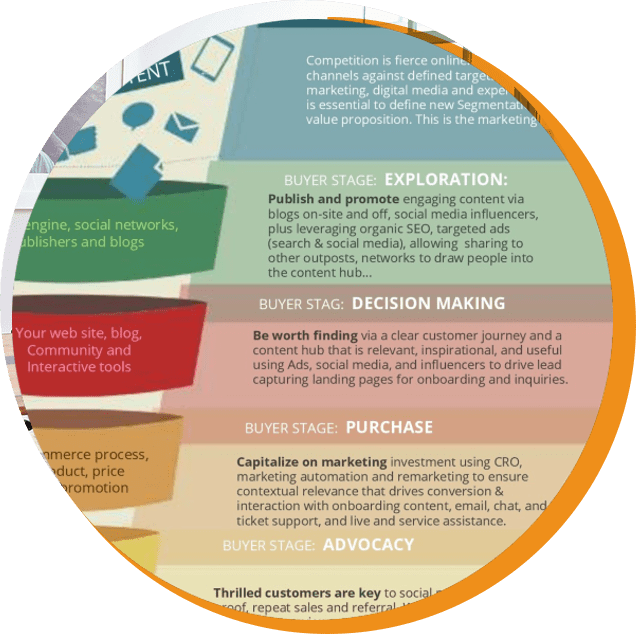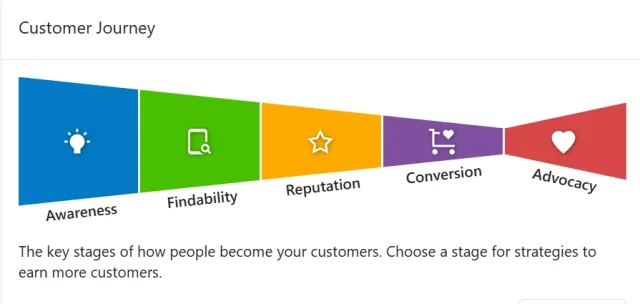

What your business needs
Digital marketing for restaurants is important, especially for new entries into the marketplace. From evolving customer expectations and emerging technologies restaurants are more at risk for disruption than ever before. Our restaurant consulting firm covers all aspects of the restaurant owner’s obstacles, and so that includes the marketing and promotion of the restaurant once it is launched.
- Social media setups
- Content Creation
- Facebook + Instagram post mgmt
- Follower engagement
- Polls & surveys
- Other media guidance included
- Keyword and phrase research
- Competition research
- Website technical audit & repair
- Content creation and optimization
- Monthly keyword rank building
- Monthly reports and adjustment
Tell a story
A good digital marketing plan begins with a brand bible (outlined in the book Breaking Boundaries by our head of marketing Bruce T. Dugan) based on your restaurant to establish consistent cross-platform messaging. We then develop content and construct an editorial calendar as to when and where the content will be posted. We also build directory networks for brand awareness.
On social media, we engage followers with a mix of promotional materials and educational, informative, and humorous to develop a brand personality people can relate with. This is part of the digital marketing plan. Ads can be managed on social, search, or video platforms. Click for more about Types of Marketing Tactics.



A marketing plan is a strategic roadmap.
It outlines how a business or organization will achieve its marketing objectives. A substantial portion of that plan will address digital channels and tools. It is a comprehensive document that guides the implementation of various online marketing tactics and campaigns to reach a target audience, build brand awareness, increase website traffic, generate leads, drive conversions, and monitor results. Here’s an overview of the key elements typically included in such a plan:
- Business and Marketing Objectives: Start by defining the overall business goals and specific marketing objectives that you aim to achieve. These could include increasing sales, expanding market reach, launching new products, or enhancing brand recognition.
- Target Audience: Identify the target audience or customer segments that the marketing efforts will focus on. Understanding the demographics, preferences, and behaviors of the target audience is crucial for creating relevant and engaging content.
- Competitor Analysis: Research to understand the strengths and weaknesses of key competitors in the digital space. Analyze their digital strategies, online presence, and customer engagement to identify opportunities and areas for improvement.
- Digital Channels and Platforms: Determine the digital channels and platforms that align with the target audience and marketing objectives. Common digital channels include websites, social media platforms, email marketing, search engines, content marketing, paid advertising, and mobile apps.
- Content Strategy: Develop a content strategy that includes valuable and relevant content for the target audience. Content can take various forms, such as blog posts, videos, infographics, whitepapers, and social media posts. The content should align with the buyer’s journey and address the audience’s pain points and interests.
- Search Engine Optimization (SEO): Implement SEO strategies to improve the website’s visibility on search engines. This involves optimizing website content, meta tags, and URLs, and obtaining quality backlinks.
- Social Media Marketing: Create a plan for social media marketing to engage with the audience, build a community, and promote content. Each social media platform may require a tailored approach based on the audience and platform characteristics.
- Email Marketing: Develop an email marketing strategy (newsletter) to nurture leads, retain customers, and deliver personalized content. Automation tools can help schedule and send targeted emails based on user behavior.
- Paid Advertising: Plan and execute paid advertising campaigns on platforms like Google Ads, Facebook Ads, or other paid media networks. Set a budget, target relevant keywords or audience segments, and measure the campaign’s performance.
- Measurement and Analytics: Establish key performance indicators (KPIs) to measure the success of marketing efforts. Use web analytics tools to track website traffic, conversions, click-through rates, and other relevant metrics. Use different tools to track social media likes, mentions, and shares. Regularly analyze data to inform decisions and optimize campaigns.
- Budget and Timeline: Allocate a budget for each marketing activity and set a timeline for the implementation of various initiatives. Prioritize activities based on their potential impact on the marketing objectives.
- Monitoring and Adaptation: Continuously monitor the performance of the marketing efforts and be ready to adapt the strategies based on the changing market trends, customer behavior, or performance insights.
Remember that a digital marketing plan is a dynamic document that may evolve as the business landscape changes. Flexibility and responsiveness to market changes are essential for successful digital marketing campaigns.
Schedule a free 30-minute consultation to learn more
The Importance of Setting SMART Goals in Restaurant Digital Marketing
Setting SMART goals—Specific, Measurable, Achievable, Relevant, and Time-bound—is crucial when crafting an effective digital marketing plan for your restaurant. Well-defined objectives provide clarity and focus, ensuring that every campaign and tactic is driving measurable progress toward your overarching business goals.
For instance, rather than aiming vaguely to “boost online sales,” setting a SMART goal like “increase online orders by 25% within six months” offers a target that can be tracked and evaluated. This level of specificity helps align your team, allocate resources efficiently, and gauge success through clear benchmarks—whether that’s via Google Analytics, email marketing platforms, or social media insights.
Additionally, SMART goals create accountability, making it easier to identify what’s working and where adjustments are needed. As the digital landscape evolves, these targeted objectives give you the flexibility to pivot and optimize campaigns, ensuring your marketing efforts deliver real value and contribute to long-term growth.
Measuring Return on Investment (ROI) for Restaurant Marketing
Tracking ROI is essential for understanding whether your marketing dollars are working hard enough for your restaurant. The basic principle is simple: compare the revenue generated by your marketing campaign to its cost.
Here’s a step-by-step approach:
- Add up the revenue linked to your campaign—for example, sales directly attributed to a seasonal promotion, email offer, or social media ad.
- Subtract your marketing expenses from the revenue generated. This includes everything from ad spend to creative costs.
- Divide the result by your marketing cost to see what proportion of your investment came back as profit.
- Multiply by 100 for a percentage result.
Suppose you invest $1,000 in a Google Ads campaign that results in $5,000 in sales. Subtract the cost ($1,000) from the revenue ($5,000) to get $4,000. Divide that $4,000 profit by the original $1,000 investment, which gives you 4, and multiply by 100—meaning your ROI is 400%.
By regularly calculating ROI for different campaigns, you can determine which marketing strategies fill more tables and which might need a refresh or a rethink. This ensures your efforts stay focused on what delivers the best results.
Online Reviews & Reputation Management
Managing your restaurant’s online reviews is vital to your overall success. These reviews influence potential diners’ decisions and shape public perception about your business long before someone walks through your doors. In today’s digital age, prospective guests often research restaurants on sites like Google, Yelp, and TripAdvisor, carefully weighing what others have experienced.
A steady stream of positive feedback can improve your search visibility, establish credibility, and ultimately attract new patrons. In many cases, even a modest improvement in your average rating can significantly impact revenue. Conversely, neglecting your online reputation can lead to lost business, as potential customers may be discouraged by unresolved complaints or a lack of responses from management.
Proactive reputation management—responding thoughtfully to reviews, resolving concerns, and encouraging happy customers to share their experiences—helps ensure your restaurant stands out in a crowded marketplace. This builds trust and loyalty, reinforcing your brand and supporting long-term growth.
Online Reviews Management: Building Trust and Enhancing Reputation
In today’s connected world, online reviews can play a pivotal role in shaping your restaurant’s public image. Effectively managing and responding to these reviews is essential for establishing credibility, winning customer trust, and growing your business. Here are practical steps to elevate your restaurant’s reputation through online reviews:
-
Be Proactive in Monitoring Social Channels: Regularly track platforms such as Google, Yelp, TripAdvisor, and Facebook for new reviews and mentions. Automated tools like Google Alerts or ReviewTrackers can streamline this process and help you stay informed in real time.
-
Respond Promptly and Professionally: Timely responses signal to guests that their feedback matters. Whether the review is positive or negative, reply with genuine appreciation and professionalism. Thank satisfied guests and address concerns raised in critical reviews—showing empathy and a willingness to resolve issues can often turn detractors into loyal advocates.
-
Personalize Your Replies: Avoid generic responses. Mention specifics from the customer’s experience to show you value their input. This level of attention demonstrates your commitment to exceptional service, encouraging repeat visits and positive word of mouth.
-
Amplify Positive Feedback: Showcase favorable reviews on your website, social media pages, or even in physical menus. Sharing real customer testimonials gives potential guests added confidence and helps reinforce a positive brand image.
-
Leverage Constructive Criticism: Use negative feedback as a source of insights for continuous improvement. Thank you for your candor and for outlining the steps being taken to address their worries. I want you to know that being transparent about how you handle criticism shows guests that you are always trying to deliver better experiences.
-
Encourage Ongoing Engagement: Motivate guests to leave reviews by creating positive experiences and gently reminding them post-visit—via receipts, table tents, or follow-up emails if you collect guest information. Express gratitude when they do, and foster a sense of community that extends beyond the dining table.
-
Maintain Visual Appeal: In addition to review management, invest in high-quality photos of your signature dishes and share them across your digital channels. Visual content captures attention and can inspire guests to visit—and leave glowing reviews of—their own.
Thoughtful online reviews management not only strengthens your restaurant’s reputation but also builds meaningful relationships with your clientele, positioning your business for sustainable growth.
Encouraging More Positive Online Reviews from Satisfied Customers
Cultivating a strong presence of authentic, positive reviews is invaluable for any restaurant’s digital reputation. To organically increase the number of positive reviews, consider weaving these tactics into your customer experience and follow-up communications:
- Make It Easy to Leave Feedback: Place links or QR codes to review sites like Google, Yelp, or TripAdvisor on guest receipts, menus, or table signage. The more straightforward the process, the more likely customers are to share their thoughts.
- Empower Your Team: Train staff to recognize moments of customer satisfaction—perhaps after receiving compliments or positive remarks—and to kindly mention how much an honest review would mean to the team and future guests.
- Follow Up After Orders: For online orders or reservations, send a warm, personalized email thanking the guest and gently suggesting they share their experience on popular review platforms, complete with direct links for convenience.
- Integrate into Your Routine: Subtle reminders, such as a note at the bottom of the check or a casual mention from a staff member, can go a long way without seeming forced.
It’s important to avoid offering incentives for reviews, as this can violate community guidelines on major platforms and may ultimately harm your establishment’s credibility. Focus on fostering genuine feedback by providing standout service—satisfied guests are often more than willing to help your restaurant shine online.
Google Business Profile & Local Citation Optimization for Restaurants
A robust local presence is essential for restaurants aiming to attract nearby diners. Start by claiming your Google Business Profile and ensuring every detail—address, contact information, menu, and hours—is accurate and up to date. High-quality images of your dishes and ambience, along with timely posts about specials or upcoming events, help create a more engaging and appealing listing.
Consistency is critical: make sure your restaurant’s name, address, and phone number appear identical across all online platforms, from your website to popular directories like Yelp, TripAdvisor, and OpenTable. Use a business listing sync tool, such as PowerListings, to add all your info in one place and then sync it across the 70 directory network. This not only establishes trust with potential guests but also strengthens your appearance in local searches. Additionally, regularly review and respond to customer feedback across platforms, as active engagement signals reliability to both diners and search engines.
Boost your visibility further by participating in local events, partnering with nearby businesses, and creating web content that highlights your connection to the community. Such efforts encourage mentions (also known as local citations) on relevant directory sites and community pages—factors that can noticeably improve your ranking in local search results.
Website Design & Content: Maximizing Online Orders and Customer Satisfaction

Marketing is simply telling a compelling story!
A well-crafted restaurant website can be the deciding factor between a new loyal customer and one who clicks away in frustration. Every element—from its visual appeal to content clarity—should be engineered with your customers’ ease in mind.
User Experience Comes First
You can start with a clean, intuitive layout that makes navigation effortless. Menus should be front and center, with clear categories and an uncomplicated path from browsing to placing an order. Streamline the workflow so customers never wonder what to do next; the fewer clicks required to order, the better. Finding, customizing, and checking out should take only a few minutes.
- Responsive Design: Ensure the site functions smoothly across desktops, tablets, and—most importantly—mobile devices. Mobile orders often make up the majority, and slow loading speeds can send hungry visitors elsewhere.
- Fast Load Times: Keep page loads under three seconds to prevent drop-offs. Tools like Google PageSpeed Insights can help audit and optimize performance.
- Simple Navigation: Prominently display call-to-action buttons like “Order Now” or “View Menu.” Use familiar icons and clear labeling for all menu items.
Content That Builds Trust
Your website isn’t just a menu—it’s a chance to tell your story and establish confidence.
- Showcase Transparency: Share information about ingredient sourcing, packaging materials (such as eco-friendly options), and hygiene standards. If you’ve won accolades or use locally sourced produce, feature these to boost credibility.
- Highlight Your Team: Brief chef bios or behind-the-scenes glimpses humanize your brand and help customers feel connected to your restaurant.
- Professional Photography: Attractive, high-resolution images of your dishes entice visitors far more effectively than text alone.
Optimized Ordering Process
Removing barriers from the ordering process increases conversions.
- Flexible Payment Options: Offer multiple methods such as credit/debit cards, Apple Pay, Google Pay, and even PayPal to accommodate various preferences.
- Clear Checkout Flow: Break down the steps explicitly and avoid unexpected charges by displaying prices and fees up front.
- Order Customization: Allow easy add-ons, substitutions, or allergy notes so customers feel catered to.
Bonus Enhancements for Customer Delight
- Include short video guides or FAQ sections to address common questions about ordering or delivery.
- Set up automated order confirmations and estimated delivery times to manage expectations.
- Offer rewards or loyalty programs directly through your website to encourage repeat visits.
A thoughtful, customer-focused website not only boosts conversion rates but also leaves a lasting impression, turning first-time visitors into repeat customers.
The Influence of Website Content on Customer Decisions
The information presented on your restaurant’s website plays a pivotal role in shaping your customers’ choices. Detailed information about your menu offerings, ingredient sourcing, and sustainability practices can reassure visitors about food quality and ethical standards—think locally sourced produce or recyclable packaging, as championed by brands such as Whole Foods or Chipotle.
Highlighting your culinary team’s background and expertise adds a personal touch and fosters a strong sense of connection—much like acclaimed restaurants share chef profiles to build credibility. Additionally, clear explanations about hygiene protocols and behind-the-scenes processes can instill confidence in new and returning guests.
Transparency across all these elements not only encourages trust but also fosters loyalty, making customers more likely to choose your restaurant over competitors.
Integrating Online Ordering With Digital Marketing Channels
When online ordering is seamlessly integrated with your digital marketing channels, the impact on your restaurant’s bottom line can be significant. Consider how these elements work together:
- Enhanced Visibility Through SEO: Optimized ordering pages improve your placement in Google results, making it easier for hungry customers to find you when they’re searching for their next meal.
- Social Media Amplification: Connecting your menu and promotions to platforms like Instagram, Facebook, and Twitter allows diners to share their favorite dishes and special offers. This word-of-mouth effect helps drive new traffic to your online storefront.
- Email Marketing Synergy: By linking your ordering system with email campaigns, you can deliver personalized offers, new menu updates, or reminders to customers who haven’t ordered in a while—keeping your brand top-of-mind (and the orders coming in).
- Actionable Analytics: Integrating analytics tools—like Google Analytics or built-in platform dashboards—gives you real-time insight into what dishes are favorites, which promotions spark interest, and where drop-offs occur. This data empowers you to refine your strategy, address pain points, and double down on what works.
The result? A connected ecosystem where every digital touchpoint invites customers to order, while your marketing dollars generate measurable returns—helping you achieve sustainable revenue growth.
Advantages of Using a Commission-Free Online Ordering System for Restaurants
Adopting a commission-free online ordering platform offers several compelling benefits for restaurants looking to enhance their digital presence and drive profitability:
-
Increased Profitability: By sidestepping the 15-30% fees typically imposed by third-party services like DoorDash or Grubhub, restaurants can retain a larger share of each sale. This means every order directly contributes more to your bottom line.
-
Direct Customer Relationships: With a direct ordering system, you gain access to your customers’ information and order history. This data is invaluable for tailoring promotions, creating loyalty programs, and building lasting customer connections—without middleman interference.
-
Consistent Branding: Deliver a seamless, branded experience every time a customer orders from you online. Customizable menus and order pages help reinforce your restaurant’s identity, setting you apart from generic listings on aggregator apps.
-
Smooth Operational Integration: Most commission-free systems are designed to integrate with your existing point-of-sale system, payment processors, and popular delivery partners. This reduces manual work and streamlines order fulfillment for both in-house and delivery services.
-
Fast and Simple Setup: Many solutions let you launch your own ordering platform in as little as 24 hours, making it easier to adapt quickly to changing customer expectations and market trends.
By integrating these online ordering capabilities with a robust digital marketing plan, restaurants can strengthen customer acquisition and retention strategies—protecting their brand, improving margins, and positioning their business for long-term success.
Schedule a free consultation
Integrating Social Media and Email Marketing for More Sign-Ups
An effective way for restaurants to boost email sign-ups is by seamlessly connecting their social media presence with their email marketing efforts. For example, promote exclusive offers or limited-time coupons on platforms like Instagram and Facebook, encouraging followers to join your email list to receive the perks. Include direct sign-up links in your social bios, Instagram Stories with swipe-up features, or Facebook posts for easy access.
You can also run targeted social media ads on platforms like Meta or TikTok that lead users to a branded email-capture landing page. Consider interactive tactics, such as hosting giveaways or contests that require newsletter subscribers. You can definitely highlight the benefits of signing up (such as birthday specials, early access menus, or event invites) to encourage followers to join.
By keeping your messaging clear and engaging across both channels, you nurture an ongoing relationship and build a loyal customer base ready to respond to your latest promotions.
Essential Strategies for Effective Email and SMS Marketing in the Restaurant Industry
Successful email and SMS marketing campaigns can play a pivotal role in building lasting customer relationships and driving repeat visits to your restaurant. Here are some best practices to ensure your communications make a positive impact:
-
Integrate Email, SMS, and Social Media Efforts: Leverage your social platforms—such as Instagram or Facebook—to encourage email and SMS sign-ups. Using a unified approach helps you expand your reach and capture more contacts.
-
Personalize Your Messaging: Tailor your newsletters and text messages by addressing customers by name and referencing their past purchases or preferences. Personal touches can enhance engagement and make your guests feel valued.
-
Deliver Value with Every Message: Focus on providing helpful content, whether that’s early access to new menu items, exclusive discounts, or information about upcoming events. Make sure the value of signing up for your communications is clear.
-
Segment Your Audience: Use data from platforms like Mailchimp or Constant Contact to segment subscribers by behavior (such as frequent diners, birthday club members, or recent online orderers). This lets you send more relevant offers to each group.
-
Craft Concise, Action-Oriented SMS: Keep text messages brief and direct, always including a clear call to action—like redeeming a lunch special, booking a reservation, or confirming event attendance.
-
Monitor and Adjust: Regularly review metrics such as open rates, click-through rates, and redemption statistics. Be ready to adapt your content or frequency as you learn what resonates most with your audience.
By thoughtfully developing your email and SMS marketing and consistently monitoring results, you can foster deeper connections with your guests and keep your restaurant top-of-mind.
Email and SMS Marketing: Why They Work for Restaurants
Email and SMS marketing have become indispensable tools for restaurants aiming to foster customer loyalty and drive repeat business. Unlike broad advertising channels, these methods let you communicate directly with guests who have already expressed interest in your offerings—often resulting in a significantly higher return on investment than traditional routes like print mail.
Key Advantages
- Direct Connection: By reaching diners right on their mobile devices or inboxes, you keep your restaurant top of mind—perfect for last-minute promos or time-sensitive specials.
- Personalization: With segmentation tools, platforms like Mailchimp or Constant Contact empower you to tailor messages based on guest preferences, purchase history, or demographics. This way, a vegetarian guest won’t receive a steakhouse promo, but rather a chef’s special plant-based menu.
- Immediate Results: Sending a special lunch deal via SMS can bring in guests the very same day, while email newsletters keep them engaged with upcoming events or seasonal menus.
- Data-Driven Insights: Platforms offer metrics that are easy to track, like open rates and click-throughs, allowing you to refine your campaigns for maximum engagement.
For restaurants, the real effectiveness comes from creating relevant, timely, and personalized communications—whether reminding customers to try your new brunch menu or offering a birthday discount. When you respect guest preferences and provide real value, email and SMS marketing can become among your most reliable revenue drivers.
The Role of Effective Subject Lines in Restaurant Email Marketing
The subject line is one of the most critical elements of any restaurant email marketing campaign. It serves as the first impression and directly impacts whether your message gets noticed or lands in the dreaded “unread” pile. A compelling subject line can capture attention amid a crowded inbox, encouraging recipients to open your email and learn more.
Crafting a strong subject line is more than simply stating a promotion—it’s about piquing curiosity, promising value, or creating a sense of urgency. For example, phrases like “Get 20% Off Your Next Lunch—Today Only” or “Your Table Awaits—Book Now and Enjoy a Complimentary Appetizer” can motivate action by highlighting timely offers or exclusive perks.
Remember, even the best-crafted email content won’t be effective if it isn’t opened in the first place. Focus on clarity, relevance, and personalization wherever possible to increase open rates and ensure your message resonates with your audience.
Practical Uses for SMS Marketing in Restaurants
Restaurants can leverage SMS marketing to reach customers directly with messages that truly matter. Here are several ideal scenarios where SMS delivers real value:
- Sharing urgent updates, such as same-day specials, flash sales, or limited-availability menu items that require immediate attention.
- Sending reservation confirmations, reminders, or waitlist updates to enhance the guest experience and reduce no-shows.
- Notifying guests about key order milestones, like pick-up times, delivery updates, or order completion.
- Delivering personalized offers for birthdays, anniversaries, or other special occasions to strengthen customer loyalty.
- Alerting subscribers to last-minute promotions or exclusive events, helping to fill seats during slower periods.
SMS’s immediacy and high open rates make it a powerful tool for driving engagement and timely action—just be sure your messages remain relevant, concise, and respectful of your guests’ preferences.
Building an Effective Email Marketing Strategy for Restaurants
Email marketing remains a highly effective channel for restaurants aiming to stay connected with their guests and increase repeat visits. To establish a successful email marketing program, start by growing a quality mailing list. For online visitors, prominently place opt-in forms on your website and encourage sign-ups with exclusive offers or updates. For in-person guests, consider collecting emails by inviting diners to participate in in-house contests or join a loyalty program—be sure to obtain consent for future communications.
Crafting compelling subject lines is key to boosting open rates. Aim for concise, value-driven messages that spark interest, such as “Enjoy $15 Off Your Next Order—Today Only!” Personalized subject lines often yield higher engagement, so segmenting your email lists by customer behavior or preferences enables more tailored communication.
Here are some practical tips to maximize your email and SMS marketing efforts:
- Integrate email campaigns with your social media channels to encourage more sign-ups.
- Personalize newsletters with the recipient’s name and relevant content that resonates with their dining history.
- Clearly communicate the advantages of joining your email list, such as exclusive discounts, early access to new menu items, or members-only events.
- Use segmentation to deliver targeted messages based on guest preferences or order frequency.
- Keep SMS communications direct and action-oriented to drive immediate engagement.
By focusing on value, personalization, and clear calls to action, your restaurant can transform email marketing into a vital tool for building loyalty and driving business growth.
Growing Your Restaurant’s Email List: Online and Offline Tactics
Building a robust email list is foundational to any restaurant’s digital marketing strategy. A thoughtfully curated list ensures your messages reach engaged customers—both diners who visit in person and guests who interact with you online. Here are proven approaches for expanding your email database through both digital and in-person channels:
Online Email List Growth Techniques:
- Website Opt-In Forms: Position simple, visually appealing sign-up forms throughout your website. The homepage, menu pages, and reservation confirmations are key touchpoints.
- Incentives for Subscription: Offer a welcome discount, free appetizer, or exclusive updates to motivate visitors to share their details.
- Reservation and Ordering Systems: Integrate email capture at checkout when guests book a table or place an order, ensuring compliance with privacy regulations.
- Social Media Integration: Promote your email list on platforms like Instagram and Facebook with a “Join our VIP list” or “Unlock member-only specials” call to action.
Offline Strategies to Capture Guest Emails:
- Tabletop Signage and QR Codes: Place tent cards or posters with QR codes directing diners to an easy sign-up landing page—ideal for capturing data during their visit.
- Loyalty and Rewards Programs: Encourage sign-ups for a loyalty program that requires an email address to track points or rewards.
- In-Restaurant Promotions: Host contests, raffles, or “Business Card Bowl” giveaways where guests enter by providing their email.
- Feedback and Survey Requests: Post-meal, invite guests to share their thoughts via a short survey, capturing their email in the process.
Remember, always make it clear what guests will receive for subscribing—whether it’s special offers, event invites, or insider news. Transparency and value make all the difference.
By combining these digital and in-person techniques, restaurants can steadily build a quality email list that fuels repeat business and deeper customer relationships.
Segmentation and Personalization in Restaurant Email Marketing
By leveraging segmentation and personalization, your restaurant’s email marketing strategy can become significantly more effective. Segmenting your email list lets you divide your audience into smaller groups based on specific criteria—such as dining preferences, visit frequency, special occasions, or location. This way, you’re not sending the same message to every subscriber; instead, you’re crafting targeted communications that speak directly to each group’s interests.
Personalized emails can include guest names, tailor recommendations based on previous orders, or feature an exclusive birthday offer. For example, a new diner might receive a welcome promo, while regular patrons could get early access to a seasonal menu. Tools like Mailchimp or Constant Contact make it easy to automate these processes.
This approach ensures your messages are more relevant, boost open rates, and encourage higher engagement—whether you’re promoting a wine tasting event, a weekend brunch special, or inviting feedback after a recent reservation. Ultimately, segmentation and personalization build loyalty and foster a stronger relationship between your brand and your guests.
How Leveraging Customer Data Enhances Restaurant Marketing
Owning your customer data provides restaurants with a strategic edge in digital marketing. When you have direct access to customer profiles and ordering history, you can create tailored campaigns that resonate with individual preferences—think targeted promotions for loyal guests or re-engagement offers sent to diners who haven’t ordered in a while.
Benefits of owning customer data include:
- Personalized Marketing: By analyzing dining habits and order frequency, you can craft bespoke emails or text messages that highlight menu favorites or introduce new offerings, fostering stronger customer relationships.
- Loyalty Programs: Build custom loyalty initiatives that reward repeat business, directly linking incentives to specific behaviors, such as referring friends or trying new dishes.
- Enhanced Feedback Loops: Solicit direct feedback from diners post-purchase, enabling real-time improvements and strengthening your brand’s reputation.
- Reduced Reliance on Third Parties: With complete control over your data, you’re no longer dependent on outside platforms that may restrict access to customer information or communications. This autonomy enables more agile, effective marketing adjustments.
- Improved ROI: Every marketing dollar goes further when you can segment audiences and send relevant offers, resulting in higher conversion rates and increased repeat patronage.
Ultimately, owning your customer data opens the door to more brilliant, more effective digital marketing—helping your restaurant stand out in a competitive landscape and build lasting loyalty over time.
Best Practices for Managing and Optimizing Restaurant PPC Campaigns
To make the most of pay-per-click (PPC) advertising for your restaurant, consider these key strategies to maximize your reach and ROI:
- Leverage Click-to-Call Options: Make it easy for mobile users to contact you by incorporating click-to-call buttons in your ads. This direct response feature can significantly boost reservations and orders.
- Prioritize Mobile Optimization: Since many diners search for restaurants on their phones, ensure your ads and landing pages load quickly and display correctly on all devices.
- Utilize Location-Based Targeting: Focus your ad spend on audiences near your restaurant by using location-based keywords and geotargeting features available on platforms like Google Ads and Facebook Ads.
- Regularly Monitor Performance Metrics: Keep a close eye on clicks, conversions, and cost-per-acquisition. Use tools like Google Analytics and Ads Manager to track results, make data-driven decisions, and adjust bids or ad copy as needed.
- Enhance Ads with Extensions: Add extra information to your PPC ads through ad extensions—such as your address, phone number, links to menu pages, or special offers. This increases visibility and improves click-through rates.
- Highlight Unique Selling Points: Craft compelling ad copy that sets your restaurant apart. For example, emphasize perks like “No delivery fee,” “Locally-sourced ingredients,” or “Fast online ordering,” depending on what makes your dining experience stand out.
By following these PPC best practices, restaurants can attract more local customers, improve ROI, and fill more tables through targeted, efficient advertising.
Benefits of a Seamless Online Ordering Experience
An efficient and intuitive online ordering process can significantly enhance a restaurant’s business performance in several important ways:
- Boosts Customer Satisfaction: A user-friendly interface allows guests to find what they’re looking for quickly, guiding them through clear menu categories, detailed descriptions, and appealing photos. This ease of use reduces frustration and increases the likelihood of repeat visits.
- Drives Higher Sales: By making customization straightforward and add-ons more visible, guests are encouraged to personalize their meals, often choosing extras or upgrades that raise the average order value.
- Improves Operational Efficiency: When online orders integrate smoothly with your POS system—think of popular solutions like Toast or Square—kitchen staff can fulfill orders swiftly, reducing errors and minimizing bottlenecks.
- Enhances Trust and Reliability: Providing accurate delivery times and real-time order tracking reassures customers that their food will arrive as promised, which builds confidence in your service.
- Strengthens Customer Loyalty: The convenience of a seamless ordering experience, combined with timely and transparent communication, encourages guests to come back, fostering long-term loyalty and positive word-of-mouth.
By investing in a seamless digital ordering process, restaurants position themselves not only to attract new customers but also to keep them coming back—pivotal for sustainable growth in an increasingly competitive marketplace.
Encouraging Direct Orders from Repeat Customers
Many restaurants rely on platforms like DoorDash, Uber Eats, and Grubhub to reach new customers, but these services often come with high fees that impact your bottom line. To foster lasting relationships and improve profitability, it’s essential to guide customers to order directly from your website or mobile app.
Consider these effective strategies:
- Exclusive Offers: Provide special discounts, loyalty rewards, or promotional deals available only through your direct ordering channels.
- Personalized Communication: Use your email newsletter and social media to let guests know about the added value of ordering directly—such as faster delivery, special menu items, or dedicated customer service.
- Website & App Experience: Make your online ordering process seamless, user-friendly, and mobile-optimized. A reliable and easy-to-navigate platform encourages customers to return.
- Clear Messaging: When packaging orders or posting on social media, include reminders highlighting the benefits of ordering directly, like supporting local businesses and enjoying potential savings.
- Loyalty Programs: Establish a simple rewards program that tracks orders placed directly and offers perks such as complimentary appetizers, birthday treats, or discounts after a certain number of visits.
By combining convenience, incentives, and clear communication, you increase the likelihood that satisfied customers will choose to order directly, strengthening both your brand and your profit margins.
Key Features to Look for in an Online Ordering System
When selecting an online ordering system, it’s crucial to prioritize features that not only streamline restaurant operations but also support broader digital marketing strategies. Here’s what to consider:
- Intuitive Menu Navigation: Choose a platform that allows for precise categorization of your menu and detailed item descriptions. Visual appeal matters—look for systems that enable you to add high-quality photos to your listings easily.
- Customization and Flexible Ordering: Ensure it offers simple customization options for customers, making it easy for them to tailor orders while minimizing confusion.
- Streamlined Checkout Process: The checkout experience should be fast and straightforward, reducing friction points that can lead to abandoned carts.
- Accurate Delivery Management: Opt for a system that provides real-time order tracking, accurate delivery time estimates, and integration with various delivery service providers for a smooth handoff.
- POS Integration: Seamless connection with your point-of-sale systems (like Toast, Square, or Clover) is crucial for syncing online orders with in-house operations and inventory.
- Customer Data and Ownership: Look for platforms that give you full ownership over customer data, including contact information and order history. This is invaluable for re-engagement, personalizing marketing, and launching loyalty programs.
- Marketing and Analytics Tools: Strong analytics capabilities and built-in marketing features—like email marketing, promo codes, integration with social media (Facebook, Instagram), and SEO-optimized ordering pages—will help you drive repeat business.
- Branding and User Experience: The system should enable you to maintain brand consistency, from colors and logos to the look and feel of your online ordering pages.
- Scalability and Support: Assess how easily the platform accommodates growth, new locations, or menu changes, and what type of customer support is available.
By weighing these functionalities, you can select an online ordering solution that does more than just process transactions—it becomes an active contributor to your customer engagement and revenue growth.
Pros and Cons of Third-Party Delivery Services
When considering online ordering, many restaurants contemplate whether to join popular third-party delivery platforms such as Grubhub, DoorDash, and Uber Eats. These services come with both distinct advantages and challenges that should be weighed as part of your broader digital marketing and operations strategy.
Benefits:
- Expanded Reach: These platforms give restaurants instant access to a large pool of potential customers actively seeking meals online, often increasing order volume from people who may not have otherwise found your business.
- Streamlined Setup: The sign-up process tends to be straightforward, with platforms handling many logistics, from app development to customer support and marketing, saving you time and upfront costs.
- Built-In Marketing: Being featured on a well-known app means extra exposure through the platform’s advertising, search, and recommendation features.
Drawbacks:
- High Commissions: The most significant downside is the commission fee, which can range from 15% to 30% of each order. These costs can quickly add up and eat into your profits, particularly on high-volume days.
- Loss of Direct Customer Relations benefits and minimize downsides, many businesses adopt a hybrid strategy—leveraging third-party platforms to attract new customership: When orders route through a third party, you lose valuable direct contact with your customers. This can limit your ability to build loyalty, gather feedback, and market your own promotions.
- Less Control Over Experience: Service quality, delivery speed, and overall customer satisfaction are partially out of your hands, potentially impacting your brand’s reputation if issues arise.
To maximize benefits and minimize downsides, many businesses adopt a hybrid strategy—leveraging third-party platforms to attract new customers while encouraging repeat orders through their own website or dedicated app to retain more revenue and enhance customer engagement.




